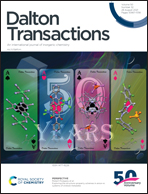Color tunable Ca8ZnM(PO4)7 (M = Lu/Tb, Lu/Eu, Tb/Eu) phosphors: luminescence, energy transfer and thermal stability studies for n-UV white LEDs†
Abstract
A series of Tb3+- and Eu3+-doped Ca8ZnLu(PO4)7 (CZLP:Tb3+ and CZLP:Eu3+) as well as Ca8ZnTb(PO4)7:Eu3+ (CZTP:Eu3+) phosphors have been prepared via the traditional high-temperature solid-state reaction. X-ray powder diffraction (XRD) patterns of the as-prepared phosphors indicate that the introduction of Tb3+ or Eu3+ affects neither the phase impurity nor the crystal structure of the CZLP host lattice. The concentration dependent photoluminescence (PL) spectra reveal that even if Lu3+ was fully substituted by the dopants, Tb3+ or Eu3+, the phenomenon of concentration quenching would not occur. Color tunable emissions from green to red can be realized by adjusting the type of doping ion (Tb3+ and Eu3+) and their relative concentration. Furthermore, the energy transfer from Tb3+ to Eu3+ was confirmed and the mechanism was determined to be the dipole–quadrupole interaction. In addition, the quantum efficiencies were found to be 0.61, 0.58 and 0.85 for CZTP, CZTP:0.2Eu3+ and CaZnEu(PO4)7 (CZEP), respectively. As a result, a white light emitting diode (WLED) device was fabricated using the optimal CZTP:0.2Eu3+ yellow phosphor, the BaMgAl10O17:Eu2+ (BAM:Eu2+) blue phosphor and a 370 nm near-ultraviolet (n-UV) chip. The obtained device displays a suitable color rendering index (CRI, ∼81.3) and correlated color temperature (CCT, ∼2634 K) value, indicating its potential application in n-UV LEDs.



 Please wait while we load your content...
Please wait while we load your content...